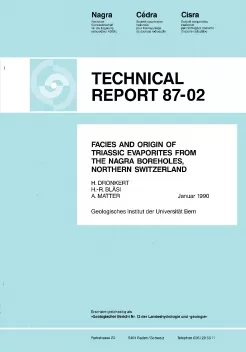
Technical Report NTB 87-02
Facies and origin of Triassic evaporites from the Nagra boreholes, Northern Switerland
The Nagra boreholes Böttstein, Leuggern, Riniken, Schafisheim and Weiach and the NOK well Beznau cored the evaporitic successions of the Gipskeuper and of the Anhydritgruppe of the Middle Muschelkalk. These formations are relatively poorly exposed in Northern Switzerland. Detailed mineralogical, textural and sedimentological analysis of these cores enabled reconstruction of the diagenetic and depositional history of the Triassic evaporites. A complex sequence of evaporitic minerals (including calcite, dolomite, gypsum, anhydrite, halite), together with chert and talc, is interpreted to represent an eogenetic assemblage. Subsequently, during mesogenetic (burial) diagenesis, gypsum dehydrated to anhydrite. Later replacement of anhydrite by mega-quartz and dolomite is recorded by sulphate-bearing carbonate beds. Concentrations of sphalerite, fluorite and mega-quartz are also present throughout the studied sequence. Ultimately, following postTertiary uplift, meteoric water ingress into the shallow-buried Triassic sediments of the Beznau, Böttstein and Leuggern wells resulted in telogenetic hydration of anhydrite, causing fracturing of the host rock and extensive dissolution of the sulphates. Although most original sedimentary structures are still preserved, practically all the primary authigenic minerals have suffered subsequent diagenetic modification since eogenesis.
Four lithofacies associations are recognised. Each comprises several subfacies of which the major ones are mentioned below.
A. Sulphate lithofacies association:
(1) Selenitic sulphate, indicating subaqueous gypsum growth
(2) Sulpharenites with ripples and other sedimentary structures, indicative of reworking and subaqueous redeposition, possibly during storms
(3)
Nodular sulphates, occurring as white or red chickenwire anhydrite (or gypsum) or as brownish impure finer grained mosaic anhydrite. These correspond to the chickenwire anhydrite of modern sabkhas and to evaporitic soils (gypcretes) respectively.
B.
Carbonate Iithofacies association consisting of brackish to hypersaline facies, including homogeneous micrites, dolomicrites and intertidal stromatolitic laminites, as well as calcarenites and -rudites.
C.
Chloride lithofacies association with halite and halite collapse breccias, massive or laminated.
D. Clay lithofacies association including:
(1)Black sapropelic clay with sulpharenites and selenite, which indicates a subaqueous origin
(2)
Greenish and brownish-red calcareous clay with sulphcrete and mudcracks, representing extensive pedogenesis on subaerial playas and coastal mud flats subject to intermittent brine flooding.
The Gispkeuper (73 – 87 m) is subdivided into 8 lithological units, which can be correlated between each of the wells. The Gipskeuper represents a large-scale regressive cycle. Numerous small-scale regressive cycles are superimposed on this, and are also correlatable from well to well. The basal part of the Gipskeuper represents deposition in large saline lagoons; later development into continental playas is recorded by the presence of nodular sulphate horizons. Development of crystalline gypsum (selenite) and sulpharenites records flooding of the playas during the lower middle Gipskeuper. Subsequent extensive sulphate soil formation took place during long periods of non-deposition leading to the formation of thick sulphcrete cycles. At the end of Gipskeuper time, inland playa and saline flood plain deposits gave way to the fluviatile sediments of the Schilfsandstein.
The Anhydritgruppe (57 – 102 m) is subdivided into eight lithological units, each composed of laterally correlatable sedimentary cycles, reflecting cyclic fluctuations in salinity. Cycles in the middle part of the Anhydritgruppe are normally terminated by brecciation and dissolution of halite or sulphate beds, while in the upper part brecciation is absent and the cycles are capped by intraformational conglomerates and nodular beds marking more stable and less saline environments. The top part of the Anhydritgruppe shows many similarities to the deposits of modern coastal sabkhas, and represents a transition towards the low energy, shallow-marine carbonate platform environments of the Hauptmuschelkalk.
